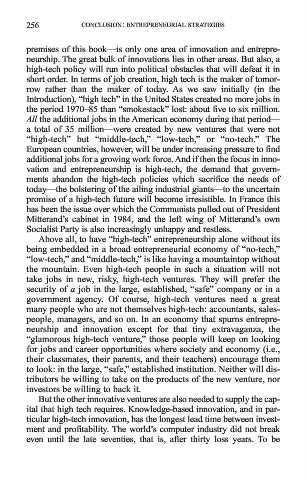Page 263 - ENTREPRENEURSHIP Innovation and entrepreneurship
P. 263
53231_Innovation and Entrepreneurship.qxd 11/8/2002 10:50 AM Page 256
256 CONCLUSION: ENTREPRENEURIAL STRATEGIES
premises of this book—is only one area of innovation and entrepre-
neurship. The great bulk of innovations lies in other areas. But also, a
high-tech policy will run into political obstacles that will defeat it in
short order. In terms of job creation, high tech is the maker of tomor-
row rather than the maker of today. As we saw initially (in the
Introduction), “high tech” in the United States created no more jobs in
the period 1970–85 than “smokestack” lost: about five to six million.
All the additional jobs in the American economy during that period—
a total of 35 million—were created by new ventures that were not
“high-tech” but “middle-tech,” “low-tech,” or “no-tech.” The
European countries, however, will be under increasing pressure to find
additional jobs for a growing work force. And if then the focus in inno-
vation and entrepreneurship is high-tech, the demand that govern-
ments abandon the high-tech policies which sacrifice the needs of
today—the bolstering of the ailing industrial giants—to the uncertain
promise of a high-tech future will become irresistible. In France this
has been the issue over which the Communists pulled out of President
Mitterand’s cabinet in 1984, and the left wing of Mitterand’s own
Socialist Party is also increasingly unhappy and restless.
Above all, to have “high-tech” entrepreneurship alone without its
being embedded in a broad entrepreneurial economy of “no-tech,”
“low-tech,” and “middle-tech,” is like having a mountaintop without
the mountain. Even high-tech people in such a situation will not
take jobs in new, risky, high-tech ventures. They will prefer the
security of a job in the large, established, “safe” company or in a
government agency. Of course, high-tech ventures need a great
many people who are not themselves high-tech: accountants, sales-
people, managers, and so on. In an economy that spurns entrepre-
neurship and innovation except for that tiny extravaganza, the
“glamorous high-tech venture,” those people will keep on looking
for jobs and career opportunities where society and economy (i.e.,
their classmates, their parents, and their teachers) encourage them
to look: in the large, “safe,” established institution. Neither will dis-
tributors be willing to take on the products of the new venture, nor
investors be willing to back it.
But the other innovative ventures are also needed to supply the cap-
ital that high tech requires. Knowledge-based innovation, and in par-
ticular high-tech innovation, has the longest lead time between invest-
ment and profitability. The world’s computer industry did not break
even until the late seventies, that is, after thirty loss years. To be

